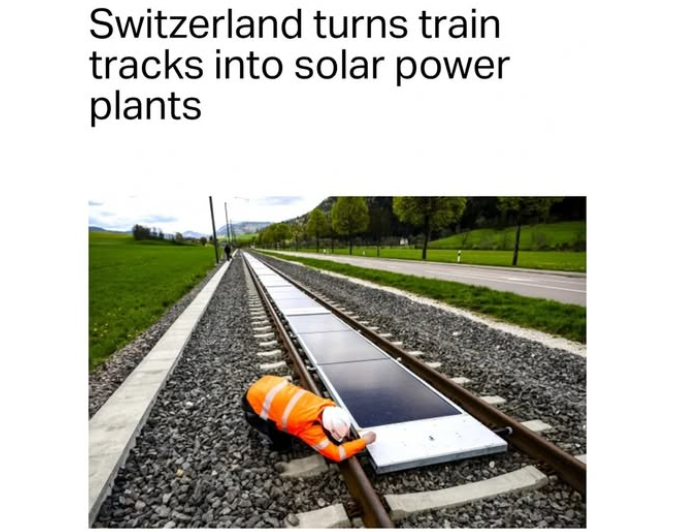A Swiss startup is testing a groundbreaking system that could transform the space between train tracks into a renewable energy source. The technology, which allows solar panels to be quickly installed and removed along railways, has garnered significant interest from international markets.
The concept first came to Joseph Scuderi in 2020 while waiting for a train at Renens station, near Lausanne. As he stood there, it struck him: why not utilize the vast stretches of unused land between the tracks?
Fast forward five years, and Scuderi’s venture, Sun-Ways, has successfully installed 100 meters of solar panels in Buttes, a small village in the canton of Neuchâtel, located in western Switzerland. Despite the rainy weather on the project’s unveiling day, Scuderi expressed immense satisfaction, calling the achievement “a miracle.”
“We installed the panels just like we would on the roof of a house,” Scuderi explained.
While solar energy integration with railways isn’t a new idea—Germany, Italy, France, and Japan are all exploring similar projects—Sun-Ways stands out for its unique, removable system. This system allows solar panels to be placed on active railways without disrupting traffic, something other projects have yet to achieve.
The panels at Buttes are fixed onto railroad ties, the supporting structures for the rails. Installation is flexible; panels can be set up manually or by a machine from Swiss track maintenance firm Scheuchzer, which can cover nearly 1,000 square meters in just hours. The panels stay in place even as trains pass, but they can be easily removed for track maintenance or replacement. Additionally, a cylindrical brush can be attached to train ends to clean the panels.
Backed by numerous partners and Innosuisse, Switzerland’s innovation promotion agency, the first phase of the Buttes project had a budget of CHF 585,000 (about $704,600).
In the eyes of Greentech Alliance co-founder Lubomila Jordanova, Sun-Ways has created a scalable and efficient method for generating clean power. Martin Heinrich from the Fraunhofer Institute for Solar Energy Systems, Europe’s largest solar research center, also supports the idea of utilizing built infrastructure, like railways, instead of disrupting natural landscapes. However, Heinrich questions the benefit of removable panels, suggesting that permanent installations might be more cost-effective.
Despite these concerns, Sun-Ways envisions its solar panels being deployed across half the world’s rail networks. The company is collaborating with projects in South Korea, Spain, and Romania, and is exploring partnerships in China and the U.S.
Taebon Park, CEO of KRSPGPC in South Korea, attended the Swiss project’s inauguration and expressed interest in applying this technology to South Korea’s extensive 6,600 km rail network. He believes Sun-Ways’ system is a perfect fit for his country’s railway operations and maintenance needs. A pilot project in South Korea is slated to begin later this year.
Meanwhile, Dieter Napitupulu, director of Mutitron Automa, a solar engineering firm in Indonesia, is keen to bring the technology to his country, starting with Bogor and expanding it throughout West Java.
Japan, too, is keeping an eye on Sun-Ways’ innovative solution. The Japanese Ministry of Landscape, Infrastructure, Transport, and Tourism (MLIT) is considering utilizing rail infrastructure for solar power production as part of its effort to meet decarbonization goals by 2050. However, the Ministry still needs to address concerns about safety and maintenance before implementation.
Joseph Scuderi and his team now face a crucial three-year period to assess the viability of integrating solar power with active railway lines. If successful, the idea that began as a passing thought at a train station could reshape the global landscape of solar energy production.










